
This fact sheet present figures of the results of the second round of the 2018 Brazilian presidential elections. The data comes from different sources:
- Items 1, 2, and 10 come from the TSE (Electoral Justice) database.
- Data and maps presented in Items 4, 5 and 6 (cities, income, race, religion) combine data from the Electoral Justice data systems with social economic indicators collected by the National Bureau of Statistics.
- The figures presented in the other items come from Datafolha electoral polls.
- General figures
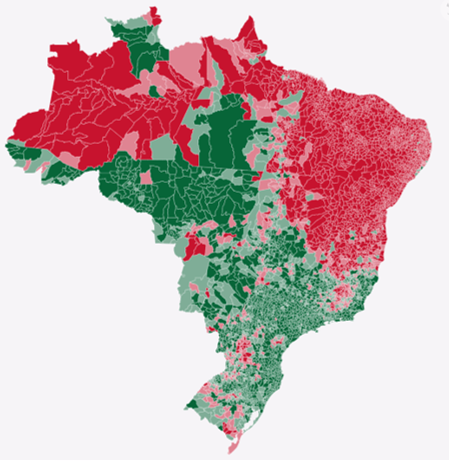
Fernando Haddad (PT) received 47 million votes, while Jair Bolsonaro (PSL) received 57,8 million, which comprise 55,13 percent of “valid” votes. Voting is obligatory in Brazil, but the so-called “valid” votes exclude abstentions, null and blank votes. When considering the totality of voters in this election there were 2,5 million blank votes (2.1 percent), 8,6 million null votes (7.4 percent) and 31,3 million abstentions (21.3 percent). This means that of the 147,3 million people apt to vote the sum of abstention, null and blank votes was of 42,1 million voters (roughly 30 percent of the total). This pattern is not new. In 2014, there were 37 million nonvoters.
Bolsonaro was, therefore, elected by 39 percent of voters, which is not a super majority. As seen 61,8 percent of Brazilian voters and potential voters did not vote for him (the sum of Haddad voter, abstentions, null and blank ballots)
- Votes by states

Bolsonaro won in 15 states, while Haddad won in 11 states. PT lost in four states, in which it had won since 2002: Amapá, Amazonas, Minas Gerais and Rio de Janeiro. Minas and Rio are the states with the second and third larger number of voters in the country, which implies this defeat had a significant role in Bolsonaro’s victory.
- Regional patterns
Bolsonaro won the South region, with 68 percent of votes, followed by the Midwest (66 percent) and the Southeast (65 percent). The PT won in all states of the Northeast with 69 percent of votes.
- Bolsonaro won the highest HDI and richest cities
A report by Estado de São Paulo newspaper informs that Haddad won in municipalities with the lower Human Development Index (HDI), while Bolsonaro won in 98 percent of higher HDI cities.

Similarly, El País reported a sharp divide between the candidates according to income. Haddad won in the poorest municipalities and Bolsonaro won in the richest.

Amongst voters who earn between five and ten minimum wages per month, 66 percent declared they would vote for Bolsonaro. Haddad won amongst families who earn less than two minimum wages.
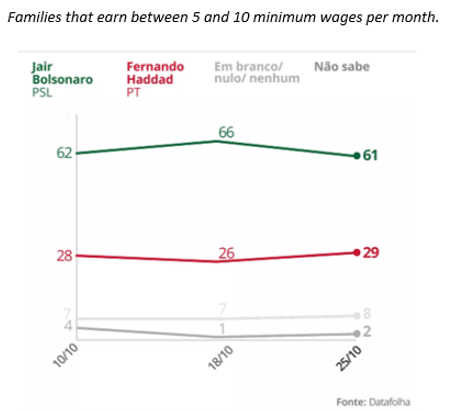
- The vote according to race/color
The El País maps also show that Bolsonaro won in the cities and states where the white population is predominant, while Haddad won in states and cities where the black population is the majority. It is important to recall the convergence of race/color and income.
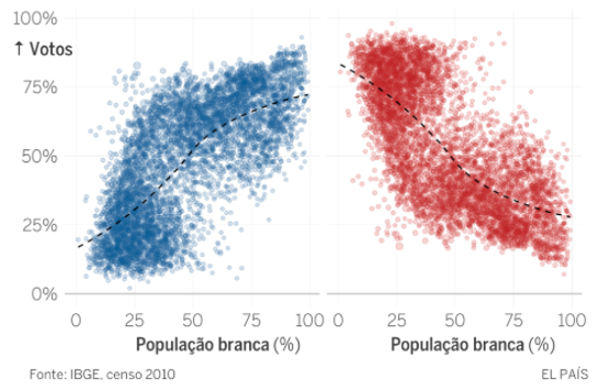
- Voting by educational levels
Bolsonaro was predominantly preferred by people with tertiary education and also 51 percent of those who ended high school. In this group, 35 percent declared they would vote for Haddad, who was preferred by a majority of voters with primary level education. Significantly enough a larger number of illiterate voters declared they would vote for Bolsonaro
- The evangelical vote
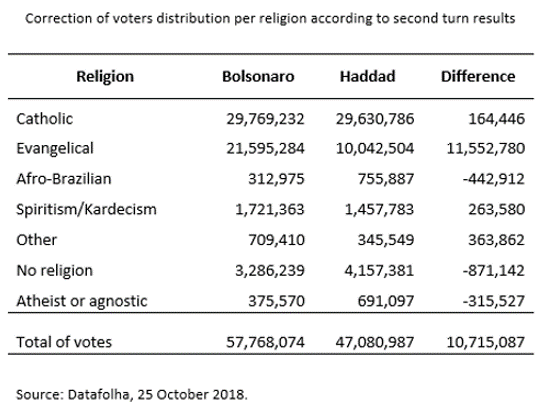
In an article published by the web platform Ecodebate, the demographer Jose Eustáquio Diniz Alves analyzed religious based voting patterns to conclude that when considering all religions and even Protestant denominations Evangelicals have massively voted for Bolsonaro: 69 percent. This meant an advantage for Bolsonaro of 11,6 million voters. This figure is larger than the overall difference amongst the candidates which was of roughly 10 million. This allows for the conclusion that the Evangelical vote has defined the results.
- Sex differentials in voting patterns.
The Electoral Justice database informs that in the whole female voters, comprise 52.5 percent of voters, but because of vote secrecy, the voting patterns cannot be disaggregated by sex. Therefore this information has to be extracted from the electoral polls. The first electoral polls (July) showed a pronounced gap difference between male and female voters. While 30 percent of male voters had already decided for Bolsonaro, just 15 percent of women declared that they will vote on him. In August, another poll revealed that 30 percent of women had not yet decided their vote. After the first round, however, the polls have shown that by late October women were sharply divided between the two candidates as shown in the Graphic below.
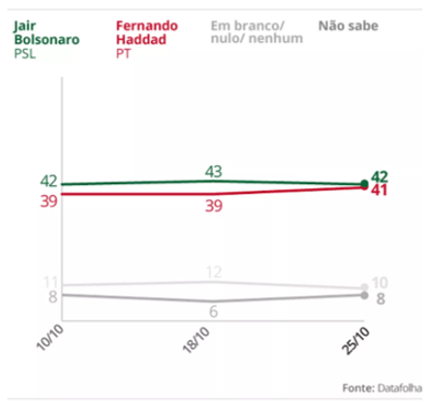
The shift of women’s vote towards Bolsonaro still requires further research, in particular, because it began to happen after the massive #EleNão marches of September 29th and expanded he won the first round. Isabela Oliveira Kali correctly remarks that the many other events and factors must be taken into account to understand this shift, such as Bolsonaro release from the hospital, declared support from the head of the largest Pentecostal Church in the country and changes in his campaign strategy.
As for men, 55 percent declared they would vote for him against just 35 percent who would vote for Haddad.
- Age differential in voting patterns
50 percent of people older than 60 years old voted for Bolsonaro, while 34 for Haddad.
When sex and age are combined, however, polls data shows that 60 percent of women aged between 16 and 24 would vote for Haddad, while amongst men in the same age span, 60 percent would vote for Bolsonaro. The sex differentials are drastically more pronounced.
- How LGBT people voted
For the first time in history, Datafolha polled voters according to the sexual orientation and gender identity of people interviewed. Haddad was preferred by percent the voters polled. Even so, the percentage of Bolsonaro potential voters was quite high: 29 percent.
For the first time, newspaper Folha de São Paulo’s research institute Datafolha used a sexual orientation axis in electoral polls, which revealed staggering results. As expected from Bolsonaro LGBTphobic claims, Haddad is preferred among the LGBT electorate, as 57 percent declared would vote for him. This leaves 29 percent of non-heterosexual people who have declared they would vote for Bolsonaro.
- How Brazilians expatriates voted
Among Brazilians who live abroad, Bolsonaro has o won with 71 percent of votes, winning in 104 cities, while Haddad received 29 percent votes winning in 19 cities. Bolsonaro had a large advantage in Japan, in the US, in Italy and Portugal. Haddad won in Cuba, Germany, France, Netherlands and Russia.
